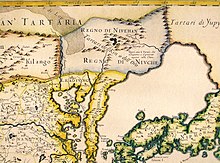http://en.m.wikipedia.org/wiki/SakhalinSakhalin (Russian: Сахалин, pronounced [səxɐˈlʲin]) is a large Russian island in the NorthPacific, lying between 45°50' and 54°24' N. It is Russia's largest island, and is administered as part of Sakhalin Oblast. Sakhalin, which is about one fifth the size of Japan, is just off the east coast of Russia, and just north of Japan.The indigenous peoples of the island are the Ainu, Oroks and Nivkhs.[2] Sakhalin has been claimed by both Russia and Japan over the course of the 19th and 20th centuries. This has led to bitter disputes between the two countries over control of the island. Russia seized the island from the Japanese near the end of World War II. Most Ainu moved to Hokkaidō when the Japanese were displaced from the island in 1949.[3]The European names derive from misinterpretation of a Manchu name ᠰ᠊ᠠᡴᡥᠠᠯᡳᡟᠠ᠊ᠠ ᡠ᠊ᠯᠠ ᠠ᠊ᠩᡤᠠ ᡥ᠊ᠠᡩᡩᠠ sahaliyan ula angga hada ("peak/craggy rock at the mouth of the Amur River"). Sahaliyan, the word that has been borrowed in the form of "Sakhalin", means "black" in Manchu and is the proper Manchu name of the Amur River (ᠰ᠊ᠠᡴᡥᠠᠯᡳᡟᠠ᠊ᠠ ᡠ᠊ᠯᠠ sahaliyan ula, literally "Black River"; see Sikhote-Alin)Sakhalin was inhabited in the Neolithic Stone Age. Flint implements, like those found in Siberia, have been found at Dui and Kusunai in great numbers, as well as polished stone hatchets, like European examples, primitive pottery with decorations like those of the Olonets, and stone weights for nets. Afterwards a population to whom bronze was known left traces in earthen walls and kitchen-middens on the Aniva Bay.Among the indigenous people of Sakhalin are the Ainu on the southern half, the Oroks in the central region and the Nivkhs on the northern part.[4] Chinese chronicled the Xianbei and Hezhetribes[citation needed], who had a way of life based on fishing.The Mongol Empire made some efforts to subjugate the native people of Sakhalin starting in about 1264 CE. According to Yuanshi, the official history of the Yuan Dynasty, the Mongols militarily subdued the Guwei (骨嵬, Gǔwéi), and by 1308, all inhabitants of Sakhalin had surrendered to the Mongols.[5] The Nivkhs and the Oroks were subjugated earlier, whereas theAinu people submitted to the Mongols later.[citation needed] Following their subjugation, Gǔwéielders made tributary visits to Yuan posts located at Wuleihe, Nanghar, and Boluohe, until the end of the Mongol Yuan Dynasty in China (1368). In the early Ming Dynasty (1368–1644), the tributary relationship was re-established. Following the introduction of Chinese political and commercial institutions in the Amur region, by the middle of the 15th century the Sakhalin Ainuwere making frequent tributary visits to Chinese-controlled outposts.[5] The Chinese in the Ming Dynasty knew the island as Kuyi or Kuwu (Chinese: 苦兀; pinyin: Kǔwù), and later (and at present) as Kuye (Chinese: 庫頁; pinyin: Kùyè). There is some evidence that the Ming eunuch admiralYishiha reached Sakhalin in 1413 during one of his expeditions to the lower Amur, and granted Ming titles to a local chieftain.[6] Under the Ming Dynasty, commerce in Northeast Asia and Sakhalin was placed under the "system for subjugated peoples", or ximin tizhi. These suggest that the island was at least nominally included under the administration of the Nurgan Regional Military Commission which was set up by Yishiha near today's village of Tyr on the Siberian mainland in 1411, and operated until the mid-1430s.[6] A Ming boundary stone still exists on the island.Bears, foxes, otters and sables are numerous, as are reindeer in the north, and musk deer, hares,squirrels, rats and mice everywhere. The bird fauna is mostly the common east Siberian, but there are some endemic or near-endemic breeding species, notably the endangered Nordmann's Greenshank (Tringa guttifer) and the Sakhalin Leaf Warbler (Phylloscopus borealoides). The rivers swarm with fish, especially species of salmon (Oncorhynchus). Numerous whales visit the sea coast, including the critically endangered Western Pacific Gray Whale, for which the coast of Sakhalin is the only known feeding ground. Other endangered whale species known to occur in this area are the North Pacific Right Whale, the Bowhead Whale and the Beluga Whale.
http://en.wikipedia.org/wiki/Nanai_people
Following the collapse of the Soviet Union and economic liberalization, Sakhalin has experienced an oil boom with extensive petroleum exploration and mining by most large oil multinational corporations. The oil and natural gas reserves contain an estimated 14 billion barrels (2.2 km³) of oil and 96 trillion cubic feet (2,700 km³) of gas and are being developed under production-sharing agreement contracts involving international oil companies like ExxonMobil and Shell.In 1996, two large consortiums signed contracts to explore for oil and gas off the northeast coast of the island, Sakhalin-I and Sakhalin-II. The two consortia were estimated to spend a combinedUS$21 billion on the two projects which almost doubled to $37 billion as of September 2006, triggering Russian governmental opposition. The cost will include an estimated US$1 billion to upgrade the island's infrastructure: roads, bridges, waste management sites, airports, railways, communications systems, and ports. In addition, Sakhalin-III-through-VI are in various early stages of development.
| Nanai children |

A 1734 French map shows the Yupipeople ("fish-skin" people) on both sides of the Ussuri and the Amur south of the mouth of the Dondon (Tondon), and theKetching people further down the Amur (where Nanai, Ulch, and Nivkh people live now)

A 1682 published Italian map showing the "Kingdom of the Niuche" (i.e., Nǚzhēn) or the "Kin (Jin) Tartars", as well as the lands of the "Yupy Tartars" - i.e. the "Fishskin Tartars" (Nanais and related tribes) further east.


Dersu Uzala In the spring of 1908, Dersu bade farewell to Arsenyev and walked back to his home in the Primorsky Krai, where he was killed.
| Primorsky Krai | |||
|---|---|---|---|
| Приморский край (Russian) | |||
| — Krai — | |||
| |||
| Anthem: none | |||
| Coordinates: 45°20′N 134°40′ECoordinates: 45°20′N 134°40′E | |||
| Political status | |||
| Country | Russia | ||
| Federal district | Far Eastern[1] | ||
| Economic region | Far Eastern[2] | ||
| Established | October 20, 1938 | ||






